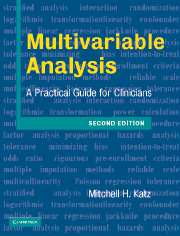Book contents
- Frontmatter
- Contents
- Preface
- 1 Introduction
- 2 Common uses of multivariable models
- 3 Outcome variables in multivariable analysis
- 4 Type of independent variables in multivariable analysis
- 5 Assumptions of multiple linear regression, multiple logistic regression, and proportional hazards analysis
- 6 Relationship of independent variables to one another
- 7 Setting up a multivariable analysis
- 8 Performing the analysis
- 9 Interpreting the analysis
- 10 Checking the assumptions of the analysis
- 11 Propensity scores
- 12 Correlated observations
- 13 Validation of models
- 14 Special topics
- 15 Publishing your study
- 16 Summary: Steps for constructing a multivariable model
- Index
4 - Type of independent variables in multivariable analysis
Published online by Cambridge University Press: 05 July 2011
- Frontmatter
- Contents
- Preface
- 1 Introduction
- 2 Common uses of multivariable models
- 3 Outcome variables in multivariable analysis
- 4 Type of independent variables in multivariable analysis
- 5 Assumptions of multiple linear regression, multiple logistic regression, and proportional hazards analysis
- 6 Relationship of independent variables to one another
- 7 Setting up a multivariable analysis
- 8 Performing the analysis
- 9 Interpreting the analysis
- 10 Checking the assumptions of the analysis
- 11 Propensity scores
- 12 Correlated observations
- 13 Validation of models
- 14 Special topics
- 15 Publishing your study
- 16 Summary: Steps for constructing a multivariable model
- Index
Summary
What type of independent variables can I use with multivariable analysis?
Interval and dichotomous independent variables can be used in all three types of multivariable analysis (Table 4.1). Ordinal and nominal variables cannot be used with any of these techniques without transforming the variables.
What should I do with my ordinal and nominal independent variables?
Don't despair. Ordinal and nominal independent variables can be incorporated into all three multivariable models by transforming them into multiple dichotomous variables. This process is usually called “dummying” by epidemiologists and biostatisticians. However, the terms “dummying” and “dummy variables” are slang. In manuscripts, you should refer to this process as creating multiple categorical variables (if you refer to it as dummying, you may, as I did, receive complaints from the reviewers of your article).
Ethnicity is probably the most common nominal variable in clinical research. Obviously, there is no numeric ordering of different ethnicities, let alone a fixed interval between them. Therefore, ethnicity is either dichotomized (e.g., white/nonwhite) or (better) is represented as several dichotomous variables in multivariable analysis. Below I have represented ethnicity as five dichotomous variables:
African-American (yes/no)
Latino/Hispanic (yes/no)
Asian/Pacific Islander (yes/no)
Native American (yes/no)
Other nonwhite (yes/no)
What happened to persons who are white/Caucasian? When you represent a nominal variable as several dichotomous variables in multivariable analysis you need one variable less than the number of categories of your variable. Why? To answer this question, think about it from the computer's point of view.
Information
- Type
- Chapter
- Information
- Multivariable AnalysisA Practical Guide for Clinicians, pp. 35 - 37Publisher: Cambridge University PressPrint publication year: 2006
